- Prepare the Soil
- Test the Soil
- Remove Weeds
- Loosen the Soil
- Add Organic Matter
- Create Raised Beds or Rows
- Use a Cover Crop
- Consider Mulching
- Provide Adequate Drainage
- Exploit Optimum Soil Conditions
- Soil Composition
- Fertilization
- Crop Rotation
- Mulching
- Irrigation
- Select the Right Seed Varieties
- Determine Your Growing Conditions
- Disease Resistance
- Yield Potential
- Growth Characteristics
- Market Demand
- Identify High-Yielding Potato Varieties
- Disease Resistance
- Adaptability to Your Climate
- All-purpose or Specialty Varieties
- Yield Potential
- Maturity Time
- Properly Space the Plants
- Spacing Guidelines
- Planting Techniques
- Benefits of Proper Spacing
- Conclusion
- Optimize Plant Density for Maximum Yields
- 1. Plant Spacing
- 2. Consider Plant Height
- 3. Soil Fertility and Nutrient Management
- 4. Adapt to Variety Characteristics
- 5. Monitor and Adjust
- Employ Proper Planting Techniques
- Choose the Right Seed Potatoes
- Prepare the Soil
- Proper Spacing
- Plant at the Right Depth
- Hilling
- Water and Fertilize Properly
- Rotate Crops
- Ensure Correct Planting Depth and Orientation
- Implement Regular Irrigation
- Maintain Consistent Soil Moisture Levels
- “Question-Answer”
- What are some tips for maximizing potato yields?
- How do I choose the right potato variety for maximum yields?
- What is the best way to prepare the soil for planting potatoes?
- When is the right time to plant potatoes?
- How far apart should potato plants be spaced?
- How often should potatoes be watered?
- What type of fertilizer should be used for potatoes?
- “Video” From Zero to 1st Early Potato Hero: Guide for Growing Determinate Potatoes in Containers
Are you a potato lover? Do you dream of harvesting big, delicious potatoes from your own backyard? Well, you’re in luck! In this article, we’ll reveal some potato planting secrets that can help you maximize your potato yields and turn your garden into a potato paradise.
Choose the Right Seed Potatoes
When it comes to potato planting, not all potatoes are created equal. It’s important to choose the right seed potatoes to ensure a successful harvest. Look for certified disease-free seed potatoes that are specifically bred for the best yield and taste. Potatoes with a good mix of sizes and shapes are ideal, as they are more likely to produce a variety of potato sizes.
Prepare your Soil
Before planting your potatoes, it’s essential to prepare your soil properly. Potatoes thrive in rich, well-draining soil with a slightly acidic pH. Remove any weeds or rocks from the planting area, and add organic matter such as compost or well-rotted manure to improve the soil’s fertility and structure. This will provide the potatoes with the nutrients they need to grow and yield a bountiful harvest.
Practice Crop Rotation
One of the secrets to maximizing potato yields is practicing crop rotation. Avoid planting potatoes in the same spot year after year, as this can increase the risk of disease and pests. Instead, rotate your potato crop with other non-related plants, such as legumes or brassicas, every year or two. This will help break the pest and disease cycles and keep your potatoes healthy and productive.
Proper Planting Techniques
When planting your potatoes, be sure to plant them at the right depth. Potatoes should be planted about 4-6 inches deep, with the eyes facing up. Space the seed potatoes about 12-15 inches apart, with rows spaced about 2-3 feet apart. This will allow the plants to grow and develop properly without overcrowding. If your soil is heavy or prone to waterlogging, consider planting your potatoes in raised beds to ensure proper drainage.
By following these potato planting secrets, you’ll be well on your way to maximizing your potato yields and enjoying a bountiful harvest. So grab your shovel and get ready to turn your garden into a potato paradise!
Prepare the Soil
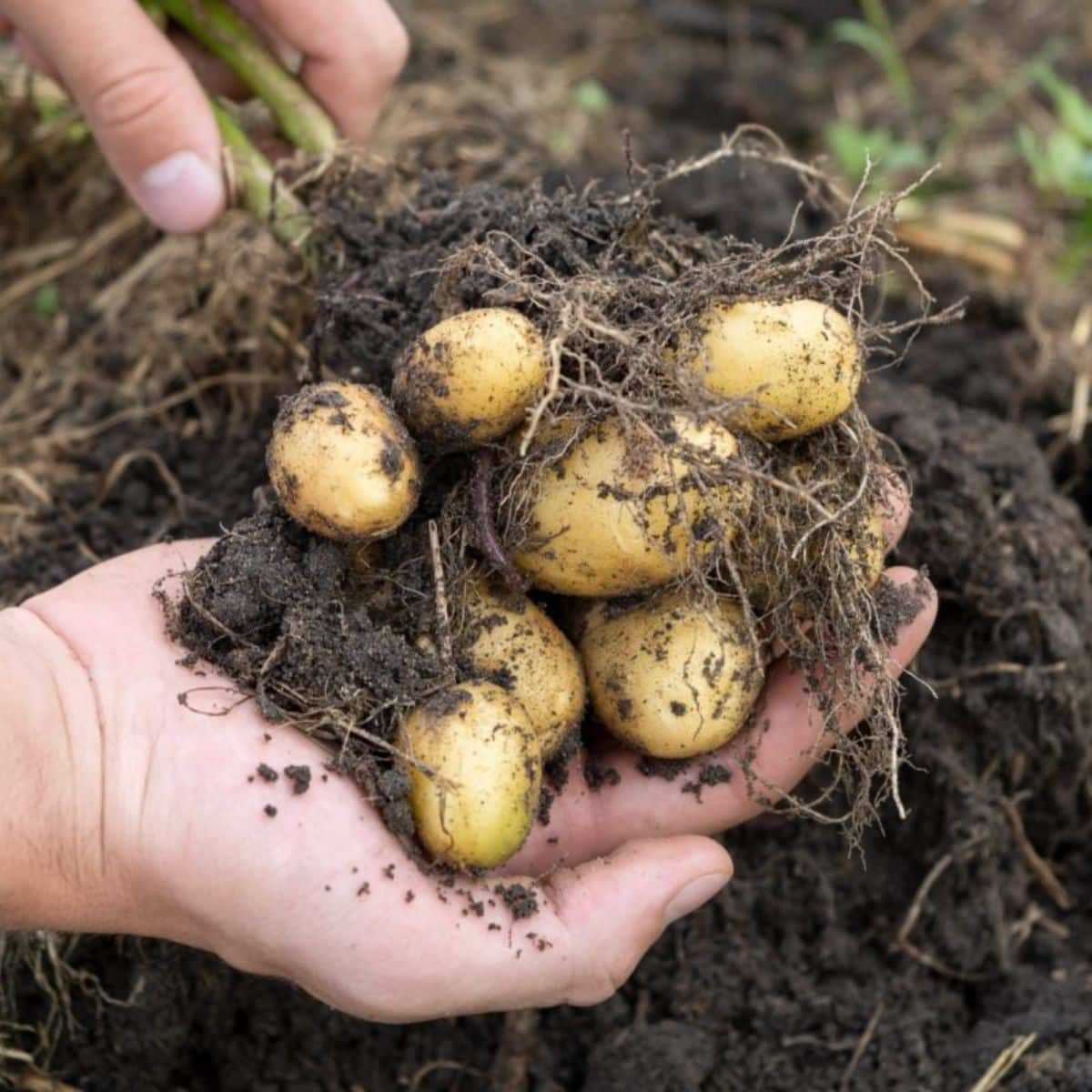
Preparing the soil is an essential step in maximizing potato yields. By ensuring that the soil is rich in nutrients, loose, and well-draining, you create the ideal environment for potatoes to grow and thrive.
Test the Soil
Before planting your potatoes, it is crucial to test the soil to determine its pH level and nutrient content. You can use a soil testing kit or send a sample to a local agricultural extension office. Adjust the pH level if necessary by adding lime or sulfur.
Remove Weeds
Prior to planting, remove any weeds from the area where you plan to grow your potatoes. Weeds compete for nutrients and moisture, and can hinder the growth of your potato plants. Use a hoe or hand-pull the weeds, being careful not to disturb the soil too much.
Loosen the Soil
Loosen the soil to a depth of at least 8 inches using a garden fork or a tiller. This helps to improve aeration and drainage, allowing the potato roots to penetrate and grow more easily. Break up any large clumps of soil and remove rocks or debris.
Add Organic Matter
Incorporate organic matter into the soil, such as compost or well-rotted manure. This will improve the soil’s fertility and moisture-retention capacity, providing the essential nutrients that potatoes need to thrive. Spread a layer of organic matter over the planting area and mix it into the top few inches of soil.
Create Raised Beds or Rows
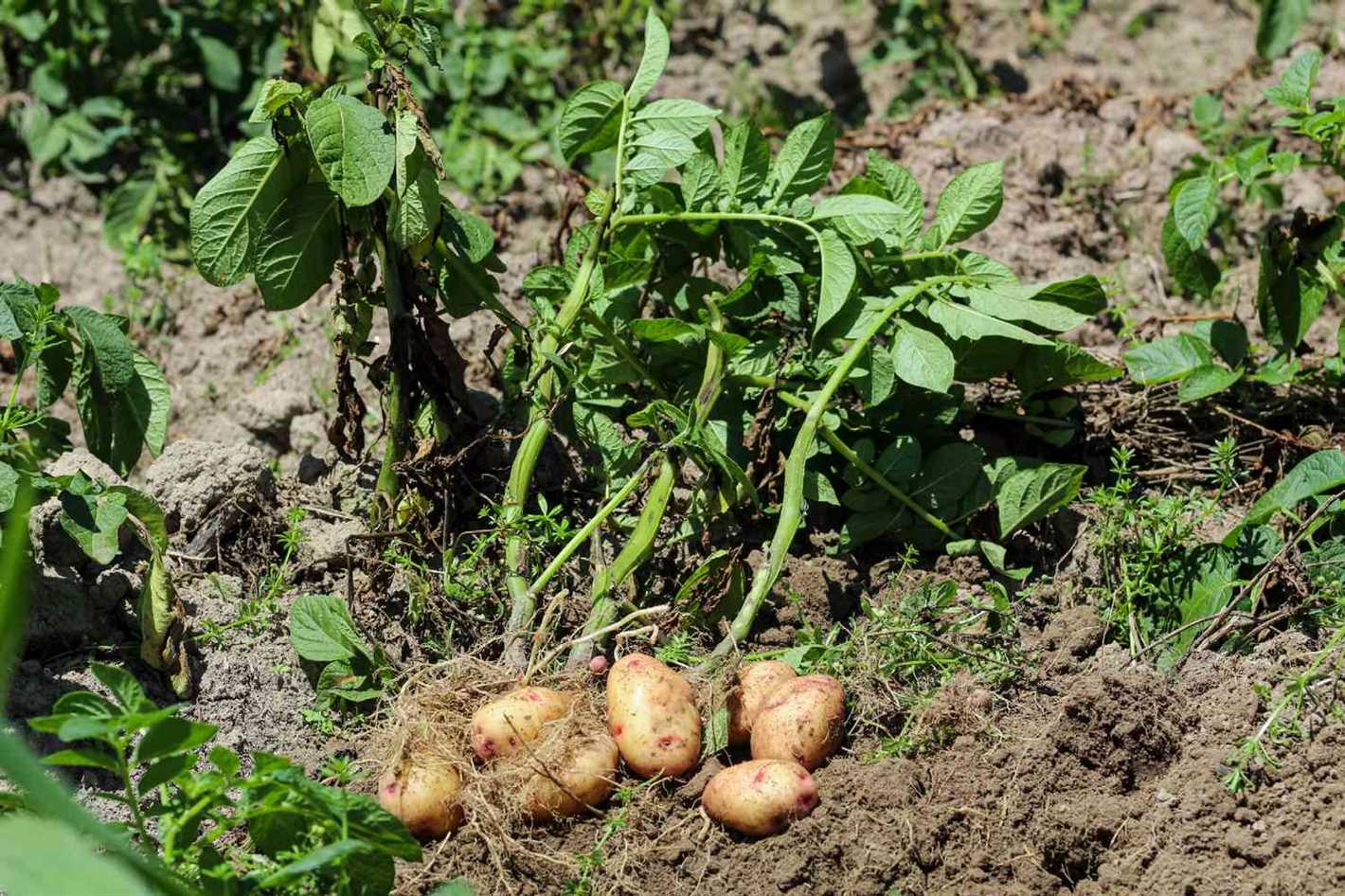
Consider creating raised beds or rows for planting your potatoes. This helps with soil drainage and prevents waterlogging, which can lead to rotting tubers. It also makes it easier to manage the plants, apply mulch, and harvest the potatoes when they are ready.
Use a Cover Crop
Planting a cover crop, such as clover or winter rye, in the fall or early spring can help improve soil quality and prevent erosion. The cover crop will help suppress weeds, add organic matter, and increase nitrogen levels in the soil, benefiting the growth of your potatoes.
Consider Mulching
Mulching your potato plants can help conserve soil moisture and control weed growth. Organic mulches, such as straw or shredded leaves, are ideal. Apply a layer of mulch around the base of the plants, taking care not to bury the stems, to inhibit weed growth and maintain soil moisture levels.
Provide Adequate Drainage
Ensure that the planting area has good drainage to prevent waterlogged soil, as excessive moisture can lead to rotting of the potato tubers. If the soil drains poorly, consider improving drainage by creating channels or adding organic matter that improves soil structure.
Exploit Optimum Soil Conditions
Creating the right soil conditions is crucial for maximizing potato yields. The following tips will help you exploit optimum soil conditions for your potato plants:
Soil Composition
- Start by testing the soil pH level. Potatoes prefer slightly acidic to neutral pH levels, ideally between 5.5 and 6.5. Adjust the pH level using lime if it is too acidic or sulfur if it is too alkaline.
- Ensure that the soil is well-draining to prevent waterlogging, which can lead to root rot and other diseases. Adding organic matter, such as compost or well-rotted manure, can improve soil drainage.
- Aim for a loose and friable soil texture to promote healthy root development. Loamy soils with a good balance of sand, silt, and clay are ideal for potatoes.
Fertilization
- Before planting, add a balanced slow-release fertilizer or well-decomposed organic matter to provide essential nutrients for your potato plants.
- Avoid excessive nitrogen fertilization, as it can result in excessive foliar growth at the expense of tuber development. Instead, focus on providing a balanced nutrient profile.
- Regularly monitor the nutrient levels in the soil throughout the growing season and make necessary adjustments to ensure an optimal nutrient balance.
Crop Rotation
- Practice crop rotation by avoiding planting potatoes in the same area for consecutive years. This helps to minimize the risk of soil-borne diseases and pests that can decrease yields.
- Ideally, rotate potatoes with non-related crops, such as legumes or brassicas, to disrupt disease cycles and replenish soil nutrients.
Mulching
- Apply a layer of organic mulch around the potato plants to conserve soil moisture and suppress weed growth. This helps maintain optimal soil conditions by reducing water evaporation and competition from weeds.
- Use straw, grass clippings, or shredded leaves as mulch, applying it around the base of the plants once they have emerged.
Irrigation
- Consistent and adequate irrigation is crucial for healthy potato growth. Monitor soil moisture levels and only water when necessary.
- Avoid over-watering as it can lead to rot and disease. Water deeply but infrequently to encourage deep root growth.
- Irrigation techniques such as drip irrigation or soaker hoses can help deliver water efficiently to the root zone.
By exploiting optimum soil conditions, you can ensure that your potato plants have the best chance of producing high yields of healthy and delicious tubers. Remember to regularly monitor your plants’ needs and make adjustments as necessary to maintain optimal soil conditions throughout the growing season.
Select the Right Seed Varieties
One of the most important factors in maximizing potato yields is selecting the right seed varieties. Different potato varieties have different growth characteristics, disease resistance, and yield potential. Here are a few factors to consider when choosing which seed varieties to plant:
Determine Your Growing Conditions
Take into account your specific growing conditions, such as climate, soil type, and sunlight availability. Some potato varieties are better suited for cool climates, while others perform well in warmer regions. Additionally, certain varieties may thrive in sandy soil, while others prefer loamy or clayey soils. Consider these factors when selecting your seed varieties.
Disease Resistance
Potatoes are prone to various diseases, such as late blight, early blight, and potato virus Y. Choosing seed varieties that have resistance to these diseases can help prevent yield losses. Look for varieties that have been specifically bred for disease resistance.
Yield Potential
Different potato varieties have varying yield potentials. Some varieties are known for their high yields, while others may produce smaller crops. Consider your planting goals and select varieties that align with your desired yield potential. Keep in mind that higher-yielding varieties may require more intensive management.
Growth Characteristics
Consider the growth characteristics of different potato varieties. Some varieties may have a shorter growing season, while others take longer to mature. Additionally, certain varieties may have a more upright growth habit, while others may spread more. Choose varieties that align with your specific needs and preferences.
Market Demand
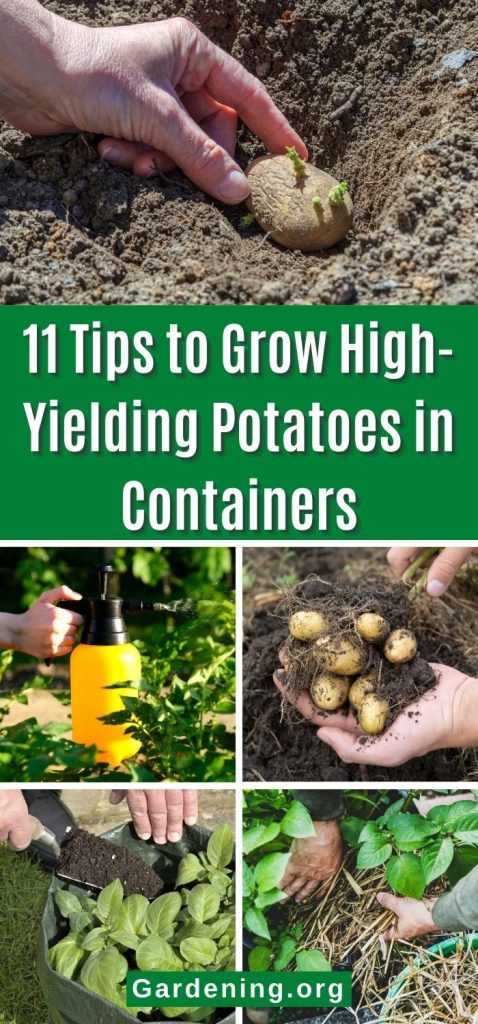
Finally, consider the market demand for different potato varieties. If you are growing potatoes for sale, it’s important to choose varieties that are in demand and have good market value. Research the preferences of your target market and select varieties accordingly.
By carefully selecting the right seed varieties for your growing conditions and goals, you can maximize your potato yields and set yourself up for a successful harvest.
Identify High-Yielding Potato Varieties
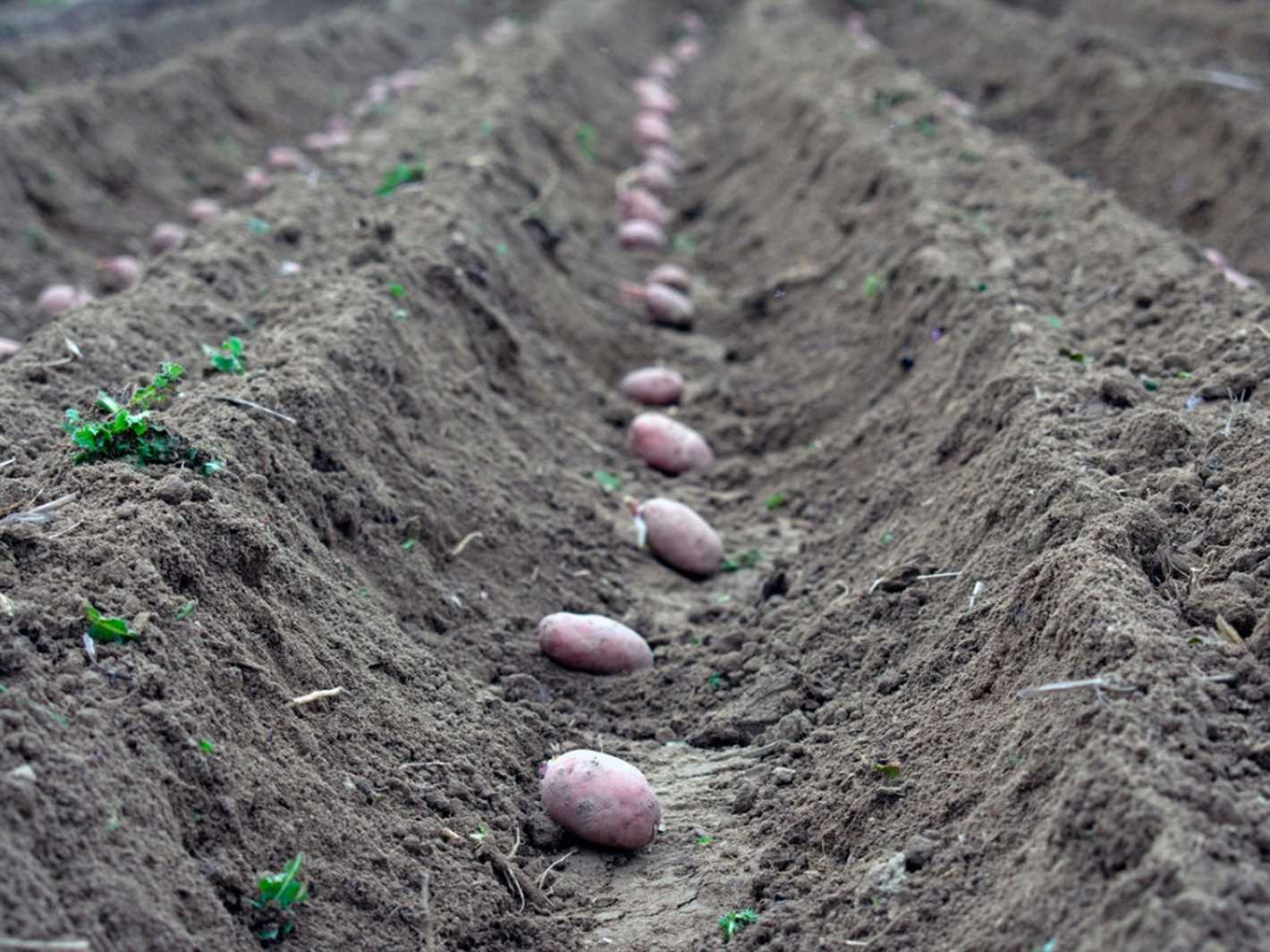
When it comes to maximizing potato yields, choosing the right variety is crucial. Some potato varieties are naturally more productive than others, so it’s essential to select high-yielding varieties for your potato planting. Here are some factors to consider when identifying high-yielding potato varieties:
Disease Resistance
Potatoes are susceptible to various diseases, such as late blight, potato virus Y, and bacterial wilt. High-yielding potato varieties often have built-in resistance to these diseases, protecting the plants from infection and allowing for better productivity. Look for varieties that are known for their disease resistance.
Adaptability to Your Climate
Potatoes are grown in a wide range of climates, from hot and dry regions to cool and moist areas. To maximize yields, it’s important to choose potato varieties that are adapted to your specific climate conditions. These varieties will thrive and produce better in your local environment.
All-purpose or Specialty Varieties
Consider your marketing strategy and the market demand for different types of potatoes. All-purpose varieties are versatile and can be used for a variety of cooking methods, while specialty varieties are often grown for their unique characteristics, such as color or flavor. Selecting the right type of potato variety that aligns with market demand can help maximize your yields and profitability.
Yield Potential
Some potato varieties have higher yield potential than others. Look for varieties that have a track record of high yields in various growing conditions. This information can often be found in seed catalogs or by consulting with local agricultural extension services.
Maturity Time
Consider the maturity time of the potato varieties you’re considering. Early maturing varieties can be harvested sooner, allowing for multiple plantings and a longer growing season. Late maturing varieties may have a longer growing season but can produce higher total yields. Choose a combination of early and late maturing varieties to extend your harvest season.
| Variety | Yield Potential | Maturity Time | Disease Resistance |
|---|---|---|---|
| Atlantic | High | Mid-season | Resistance to late blight and common scab |
| Russet Burbank | High | Late-season | Resistance to late blight and potato virus Y |
| Kennebec | High | Mid-season | Resistance to late blight and bacterial wilt |
Remember, selecting the right potato variety is a crucial step in maximizing your yields. Take into account disease resistance, adaptability to your climate, market demand, yield potential, and maturity time when choosing high-yielding potato varieties for your planting.
Properly Space the Plants
Proper spacing of potato plants is essential for maximizing yields. When potato plants are too close together, they compete for sunlight, water, and nutrients, which can result in smaller and fewer tubers. On the other hand, if potato plants are spaced too far apart, valuable growing space may be wasted.
Spacing Guidelines
When planting potatoes, it is recommended to space the plants approximately 12 to 15 inches apart. This spacing provides enough room for each plant to grow and develop a healthy root system. By giving each plant enough space, you ensure that they have access to sufficient nutrients and water.
Keep in mind that spacing requirements may vary depending on the potato variety and the available growing area. Some potato varieties, such as those bred for larger tubers, may require slightly wider spacing to allow enough room for the tubers to develop properly.
Planting Techniques
There are several planting techniques that can help ensure proper spacing of potato plants:
- Row Planting: Planting the potato plants in rows allows for easier access and maintenance. The rows should be spaced approximately 2 to 3 feet apart to provide enough space for walking and tending to the plants.
- Hill Planting: Another popular technique is hill planting, where the potato plants are placed in mounds or hills. Each hill should have 2 to 3 potato plants, with a spacing of 12 to 15 inches between each plant. The hills should be spaced approximately 2 to 3 feet apart.
Benefits of Proper Spacing
Properly spacing the potato plants offers several benefits:
- Optimal Growth Conditions: Each plant has enough space to grow and access sunlight, water, and nutrients, resulting in healthier and more vigorous plants.
- Improved Air Circulation: Adequate spacing between plants allows for better air circulation, reducing the risk of fungal diseases and promoting faster drying of foliage after rainfall or watering.
- Easier Harvesting: Proper spacing makes it easier to harvest the potatoes, as the plants are more accessible, and there is less risk of damaging neighboring plants.
Conclusion
Proper spacing of potato plants is crucial for maximizing yields. Following the recommended spacing guidelines and using appropriate planting techniques can ensure that each plant has enough space to thrive and produce healthy tubers. By providing optimal growing conditions, you can enjoy a bountiful potato harvest.
Optimize Plant Density for Maximum Yields
One of the key factors in maximizing potato yields is optimizing plant density. Plant density refers to the number of potato plants you grow per unit area of land. By carefully managing plant density, you can ensure that each plant has enough space to grow and receive the necessary nutrients and sunlight for optimal growth. Here are some tips to help you optimize plant density for maximum yields:
1. Plant Spacing
Proper plant spacing is crucial for maximizing potato yields. If plants are too close together, they will compete for resources and inhibit each other’s growth. On the other hand, if plants are spaced too far apart, you may not utilize the available growing space efficiently.
For indeterminate varieties, aim for a spacing of 12-15 inches between plants within a row, and 30-36 inches between rows. For determinate varieties, you can reduce the spacing to 9-12 inches between plants and 24-30 inches between rows.
2. Consider Plant Height
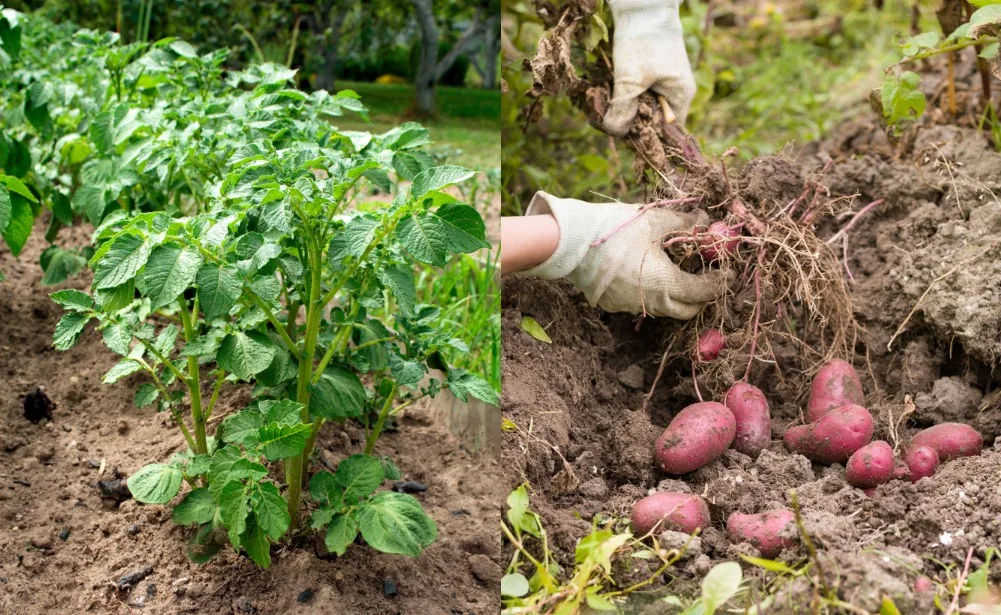
When determining plant density, consider the anticipated height of the potato plants. Plants that grow taller will require more space between them to ensure adequate airflow and light penetration. This will help prevent the development of diseases such as blight and maximize photosynthesis for better tuber development.
3. Soil Fertility and Nutrient Management
Optimizing plant density also involves considering the fertility of the soil and managing nutrient levels. Ample availability of nutrients, particularly potassium and phosphorus, is crucial for healthy potato growth. Adequate soil fertility and nutrient management practices will help ensure that each plant has the necessary resources to produce high-quality tubers.
4. Adapt to Variety Characteristics
Different potato varieties have different growth habits and requirements. Some varieties naturally grow more compact, while others have a more sprawling growth habit. It’s important to adapt plant density based on the characteristics of the variety you are growing to optimize yields.
5. Monitor and Adjust
Regularly monitor your potato plants throughout the growing season. Watch for signs of overcrowding, such as stunted growth, yellowing leaves, or increased susceptibility to diseases. If necessary, make adjustments to the plant density by thinning out excess plants or spacing them further apart to optimize yields.
By optimizing plant density, you can maximize potato yields and achieve healthier, more abundant harvests. Remember to consider plant spacing, plant height, soil fertility, variety characteristics, and make necessary adjustments as needed. With proper plant density management, you’ll be well on your way to growing an impressive potato crop.
Employ Proper Planting Techniques
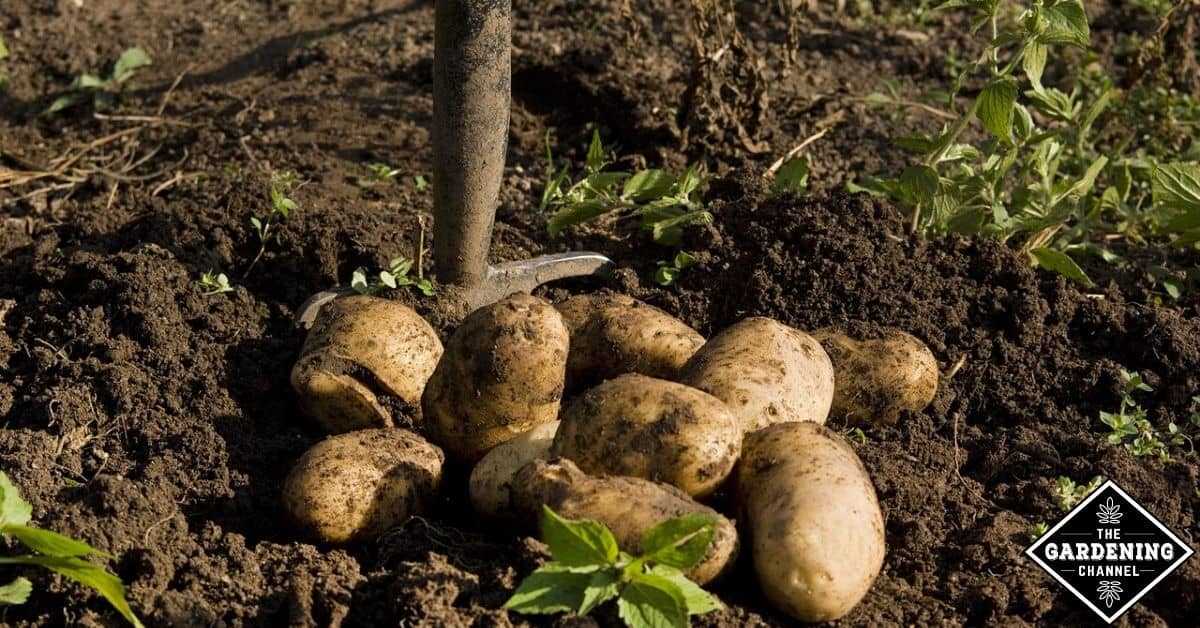
Proper planting techniques are crucial for maximizing potato yields. By following these tips, you can ensure that your potato plants have the best chance of thriving and producing a bountiful harvest.
Choose the Right Seed Potatoes
Start by selecting high-quality seed potatoes. Look for certified disease-free potatoes that have good sprouting potential. Avoid using potatoes from the grocery store, as they may be treated with chemicals to inhibit sprouting.
Prepare the Soil
Before planting, prepare the soil by loosening it to a depth of at least 6 inches (15 cm). Remove any weeds, rocks, or other debris that could hinder the growth of your potato plants. Incorporate organic matter, such as compost or well-rotted manure, to improve soil fertility and drainage.
Proper Spacing
Give your potato plants enough space to grow and develop. Plant them in rows that are spaced at least 2 to 3 feet (60 to 90 cm) apart. Within the rows, space the seed potatoes about 12 inches (30 cm) apart. This spacing allows the plants to receive adequate sunlight, air circulation, and access to nutrients.
Plant at the Right Depth
Plant the seed potatoes at a depth of about 4 to 6 inches (10 to 15 cm) in the soil. This ensures that the tubers have enough soil cover to protect them from sunlight, which can turn them green and make them inedible. It also provides insulation and stability for the growing plants.
Hilling
Hilling is an important technique for maximizing potato yields. As the potato plants grow, regularly mound soil around the stems, leaving only the top few leaves exposed. This helps to create more space for tubers to develop and protects them from greening. Hilling also assists in controlling weeds and prevents tubers from becoming exposed to sunlight, which can decrease yields.
Water and Fertilize Properly
Consistent moisture is essential for potato plants, especially during tuber formation. Water deeply whenever the top inch (2.5 cm) of soil feels dry. Avoid over-watering, as this can lead to rot. Additionally, provide adequate nutrition by fertilizing the potato plants as needed. Conduct a soil test to determine the specific nutrient requirements and use a balanced fertilizer accordingly.
Rotate Crops
Rotate your potato crops each year to reduce the risk of diseases and pests. Avoid planting potatoes in the same spot for at least three years. This practice helps to prevent the build-up of pathogens, maintains soil fertility, and ensures healthier plants.
By employing proper planting techniques, you can set the stage for a successful potato harvest. Take the time to prepare the soil, choose the right seed potatoes, and provide the necessary care throughout the growing season. Your efforts will be rewarded with higher yields and healthier plants.
Ensure Correct Planting Depth and Orientation
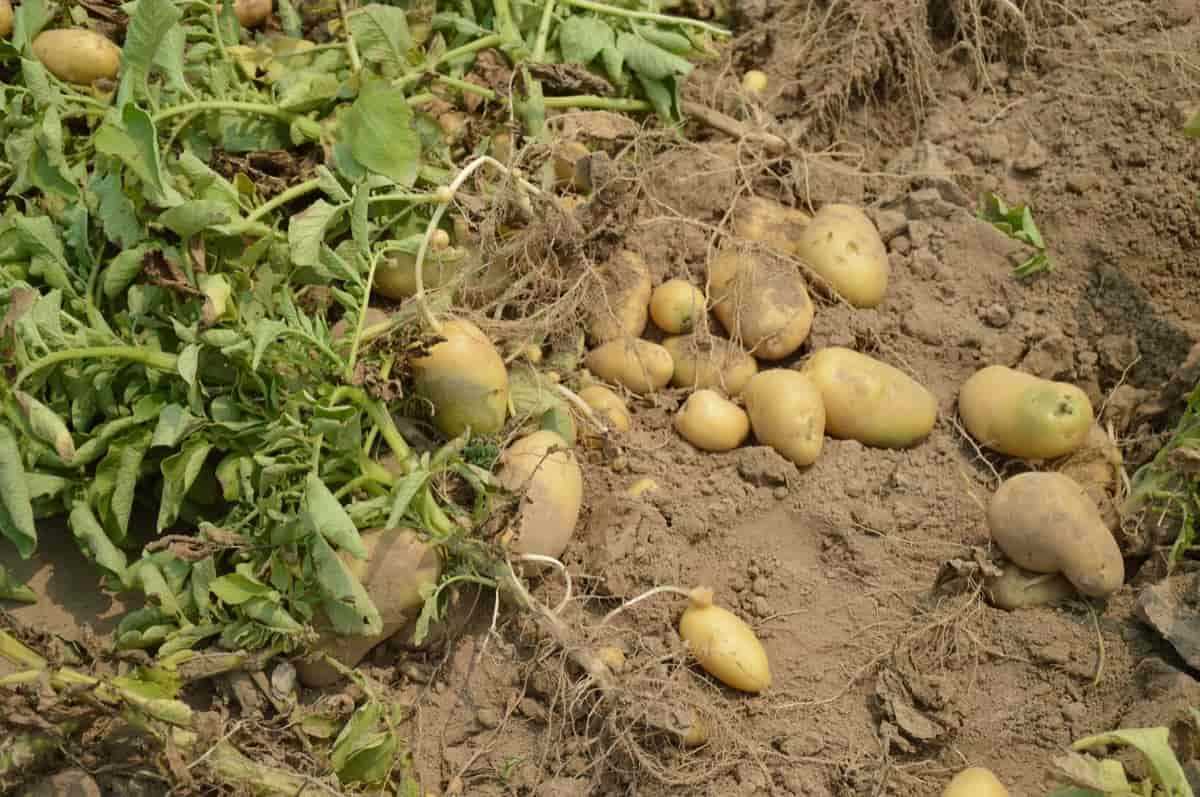
- Planting potatoes at the correct depth ensures optimal growth and maximum yields.
- The ideal planting depth for potatoes is typically around 4 inches (10 centimeters) deep.
- Planting depth can vary depending on soil type, weather conditions, and the size of the potato tubers.
- If the tubers are planted too shallow, they may dry out quickly and be more susceptible to damage from pests and diseases.
- On the other hand, if the tubers are planted too deep, they may have difficulty reaching the surface, leading to stunted growth.
- Before planting, it’s recommended to prepare the soil by removing any rocks or debris and loosening it to a depth of at least 8 inches (20 centimeters).
- If your soil is heavy or compacted, it’s beneficial to add organic matter, such as compost or well-rotted manure, to improve drainage and aeration.
- When planting, position the seed potatoes with the eyes facing up, as these are where the sprouts will emerge.
- For larger seed potatoes, you can cut them into smaller pieces, making sure each piece has at least one or two eyes for sprouting.
- If you’re planting multiple rows, space them about 2 to 3 feet (60 to 90 centimeters) apart to allow for proper growth and easy maintenance.
Implement Regular Irrigation
One of the most important factors in maximizing potato yields is regular irrigation. Potatoes require a consistent supply of moisture to develop properly and produce large, healthy tubers. Implementing an effective irrigation system is crucial to ensure that your potato plants receive the proper amount of water throughout the growing season.
There are several methods you can use to irrigate your potato plants. One popular option is using a sprinkler system, which evenly distributes water over the entire potato field. This method is particularly useful for larger-scale potato farming operations. Another option is using soaker hoses or drip irrigation, which deliver water directly to the base of the plants, minimizing water waste and maximizing efficiency.
It is important to water your potato plants consistently throughout the growing season. Potatoes need about 1-2 inches of water per week, either from rainfall or irrigation. However, make sure not to overwater your plants, as this can lead to disease and root rot. Monitor soil moisture levels regularly and adjust irrigation accordingly.
Timing is also key when it comes to potato irrigation. It is best to water your potato plants in the early morning or late afternoon to minimize evaporation and ensure that the water has time to penetrate deep into the soil before the heat of the day. Avoid watering in the evening, as this can create a humid environment that is favorable for disease development.
In addition to regular irrigation, it is important to mulch around your potato plants to help retain moisture in the soil. Apply a layer of organic mulch, such as straw or wood chips, around the base of the plants. This will help to prevent water evaporation, keep the soil cool, and suppress weed growth.
By implementing regular irrigation and monitoring soil moisture levels, you can ensure that your potato plants receive the optimal amount of water throughout the growing season. This will help to maximize yields and produce healthy, robust potatoes.
Maintain Consistent Soil Moisture Levels
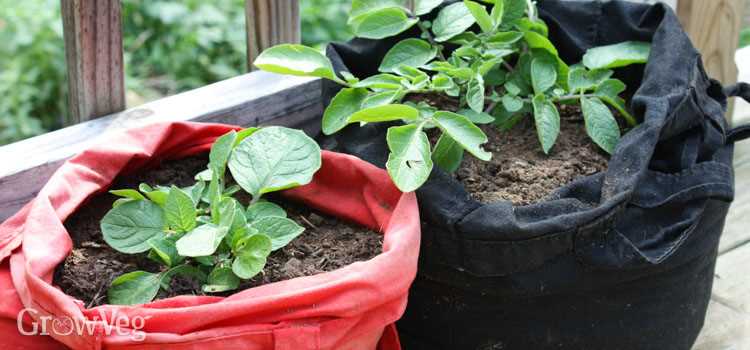
In order to maximize potato yields, it is crucial to maintain consistent soil moisture levels throughout the growing season. This ensures that the potatoes have adequate water for proper growth and development.
Here are some tips on how to maintain consistent soil moisture levels:
- Irrigation: Implement a regular irrigation schedule to ensure that the soil is adequately watered. The frequency and amount of water will depend on the specific variety of potato and the climate in your region. Monitor the moisture levels by checking the soil’s moisture content regularly.
- Mulching: Apply a layer of organic mulch, such as straw or wood chips, around the potato plants. This helps to retain moisture in the soil by preventing evaporation. Mulching also helps to regulate soil temperature and suppress weed growth.
- Proper Drainage: Ensure that the planting area has proper drainage to prevent waterlogged soil, which can lead to rot and disease. If necessary, improve drainage by adding organic matter or creating raised beds.
- Monitor Rainfall: Keep track of the amount of rainfall in your area. If there is insufficient rainfall, supplement with irrigation. Likewise, if there is excessive rainfall, take measures to prevent waterlogging.
By maintaining consistent soil moisture levels, you can provide the optimal growing conditions for your potato plants and maximize your yields.
“Question-Answer”
What are some tips for maximizing potato yields?
Some tips for maximizing potato yields include choosing the right variety, preparing the soil properly, planting at the right time, spacing the plants correctly, and providing proper watering and fertilization.
How do I choose the right potato variety for maximum yields?
To choose the right potato variety for maximum yields, consider factors such as the growing season length, disease resistance, and intended use of the potatoes (e.g. boiling, frying, etc.). Different varieties have different characteristics that can affect their yield potential.
What is the best way to prepare the soil for planting potatoes?
The best way to prepare the soil for planting potatoes is to loosen it with a garden fork or tiller, remove any weeds or rocks, and incorporate organic matter like compost or well-rotted manure. This will help improve the soil structure and fertility, providing a better environment for the potato plants to grow.
When is the right time to plant potatoes?
The right time to plant potatoes depends on the local climate and the specific potato variety. In general, potatoes are typically planted in early spring, when the soil temperature reaches around 45-50°F (7-10°C). Planting too early when the soil is still cold can hamper tuber development, while planting too late may lead to smaller yields.
How far apart should potato plants be spaced?
Potato plants should typically be spaced about 12-18 inches (30-45 cm) apart, depending on the variety. This spacing allows the plants to receive adequate sunlight and airflow, which can help prevent diseases and promote better tuber development.
How often should potatoes be watered?
Potatoes should generally be watered evenly and consistently throughout the growing season. The soil should be kept moist but not waterlogged. As a general guideline, potatoes usually require about 1-2 inches (2.5-5 cm) of water per week, either from rainfall or supplemental irrigation.
What type of fertilizer should be used for potatoes?
For potatoes, it is best to use a balanced fertilizer with a ratio of nitrogen (N), phosphorus (P), and potassium (K) such as a 10-10-10 or 14-14-14. The fertilizer should be applied before planting and may need to be supplemented throughout the growing season based on soil test results and plant nutrient requirements.







